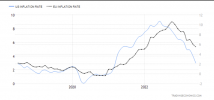The Bank of Japan surprised financial markets by easing its grip on bond yields, with Governor Kazuo Ueda's first unexpected move since taking office. Japan's benchmark bond yield surged above the previous 0.5% cap set by the central bank. The yen experienced volatility, initially falling over 1%, then rallying about the same amount, and finally giving up those gains.
The BOJ maintained its target for 10-year yields around 0% but clarified that the 0.5% ceiling is now a reference point, not a rigid limit, to enhance the flexibility of its easing program. Additionally, it announced a daily purchase of 10-year government debt at 1%, while maintaining its short-term negative interest rate at -0.1%. Governor Ueda emphasized that this move is not a step towards normalization as short-term rates are still far from being raised.
Market speculation about yield curve control policy changes has persisted since the previous year, given the global trend of policy tightening to combat inflation. Despite inflation projections averaging over 2% this year, the BOJ expects it to weaken below the target in the next fiscal year, indicating the need for continued stimulus.
Some analysts believe that the BOJ's decision to buy 10-year government debt at 1% implies an effective doubling of the movement range and signifies a start of withdrawal from yield curve control. While only a small percentage of economists predicted this change, Ueda likely chose this timing to avoid future risks and make adjustments while market conditions were relatively stable.
The move has sparked diverse opinions, and Ueda's communication approach has been questioned, as it was seen as a bold and unexpected step. The BOJ's adjustment is viewed as an early move towards eventually exiting the YCC policy down the road, and it might favor yen appreciation in the currency markets.
The BOJ maintained its target for 10-year yields around 0% but clarified that the 0.5% ceiling is now a reference point, not a rigid limit, to enhance the flexibility of its easing program. Additionally, it announced a daily purchase of 10-year government debt at 1%, while maintaining its short-term negative interest rate at -0.1%. Governor Ueda emphasized that this move is not a step towards normalization as short-term rates are still far from being raised.
Market speculation about yield curve control policy changes has persisted since the previous year, given the global trend of policy tightening to combat inflation. Despite inflation projections averaging over 2% this year, the BOJ expects it to weaken below the target in the next fiscal year, indicating the need for continued stimulus.
Some analysts believe that the BOJ's decision to buy 10-year government debt at 1% implies an effective doubling of the movement range and signifies a start of withdrawal from yield curve control. While only a small percentage of economists predicted this change, Ueda likely chose this timing to avoid future risks and make adjustments while market conditions were relatively stable.
The move has sparked diverse opinions, and Ueda's communication approach has been questioned, as it was seen as a bold and unexpected step. The BOJ's adjustment is viewed as an early move towards eventually exiting the YCC policy down the road, and it might favor yen appreciation in the currency markets.


